Great White Fleet
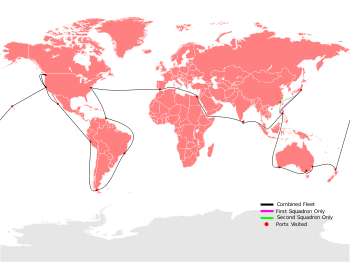
| ||
|---|---|---|
President of the United States First term Second term Post Presidency
|
||
The Great White Fleet was the popular nickname for the United States Navy battle fleet that completed a journey around the globe from December 16, 1907, to February 22, 1909, by order of United States President Theodore Roosevelt.[1][2]
It consisted of 16 battleships divided into two squadrons, along with various escorts.[1][2] Roosevelt sought to demonstrate growing American military power and blue-water navy capability. Hoping to enforce treaties and protect overseas holdings, the United States Congress appropriated funds to build American sea power. Beginning with just 90 small ships, over one-third of them wooden, the navy quickly grew to include new modern steel fighting vessels. The hulls of these ships were painted a stark white, giving the armada the nickname "Great White Fleet".[3]
Background and purpose
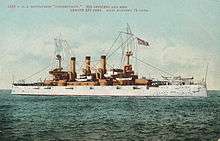
In the twilight of his administration, United States President Theodore Roosevelt dispatched sixteen U.S. Navy battleships of the Atlantic Fleet on a worldwide voyage of circumnavigation from 16 December 1907 to 22 February 1909.[1][2] The hulls were painted white, the Navy's peacetime color scheme, decorated with gilded scrollwork with a red, white, and blue banner on their bows. These ships would later come to be known as the Great White Fleet.
The purpose of the fleet deployment was multifaceted. Ostensibly, it served as a showpiece of American goodwill as the fleet visited numerous countries and harbors. In this, the voyage was not unprecedented. Naval courtesy calls, many times in conjunction with the birthdays of various monarchs and other foreign celebrations, had become common in the 19th century. They became increasingly important with the rise of nationalism. In 1891, a large French fleet visited Kronstadt, Russia in conjunction with negotiations between the two nations. Although France and Russia had been hostile to each other for at least three decades prior, the significance of the call was not lost on Russia, and Tsar Nicholas II signed a treaty of alliance with France in 1894. As navies grew larger, naval pageants grew longer, more elaborate and more frequent. The United States began participating in these events in 1902 when Roosevelt invited Kaiser Wilhelm II of Germany to send a squadron for a courtesy call to New York City. Invitations for U.S. Navy ships to participate in fleet celebrations in the United Kingdom, France and Germany followed.[4]
Additionally, the voyage of the Great White Fleet demonstrated both at home and on the world stage that the U.S. had become a major sea power in the years after its triumph in the Spanish–American War, with possessions that included Guam, the Philippines, and Puerto Rico.[5] It was not the first flexing of U.S. naval muscle since that war, however; during the Algeciras Conference in 1906, which was convened to settle a diplomatic crisis between France and Germany over the fate of Morocco, Roosevelt had ordered eight battleships to maintain a presence in the Mediterranean Sea.[6] Since Japan had arisen as a major sea power with the 1905 annihilation of the Russian fleet at Tsushima, the deployment of the Great White Fleet was therefore intended, at least in part, to send a message to Tokyo that the American fleet could be deployed anywhere, even from its Atlantic ports, and would be able to defend American interests in the Philippines and the Pacific.[7][8]
That gesture capitalized on a war scare that had resulted from anti-Japanese riots in San Francisco. Roosevelt saw the deployment of the fleet as one that would take the American public's mind off an economic depression that had begun in 1907, encourage patriotism, and give the impression that he would teach Japan "a lesson in polite behavior", as historian Robert A. Hart phrased it.[9] Roosevelt did so on the assurance from financial experts that Japan had been drained from the Russo-Japanese War and would not be ready for another conflict for at least a decade.[9] After the fleet had crossed the Pacific, Japanese statesmen realized that the balance of power in the East had changed since the Root–Takahira Agreement that defined relevant spheres of interest of the United States and Japan.[7]
The voyage also provided an opportunity to improve the sea- and battle-worthiness of the fleet. While earlier capital ship classes such as the Kearsarge, Illinois and Maine were designed primarily for coastal defense, later classes such as the Virginia and Connecticut incorporated lessons learned from the Spanish–American War and were conceived as ships with "the highest practicable speed and the greatest radius of action", in the words of the appropriation bills approved by the United States Congress for their construction. They were intended as modern warships capable of long-range operations. Nevertheless, the experience gained in the recent war with Spain had been limited.[10]
Concerns and preparations
Roosevelt's stated intent was to give the navy practice in navigation, communication, coal consumption and fleet maneuvering; navy professionals maintained, however, that such matters could be served better in home waters. In light of what had happened to the Russian Baltic Fleet, they were concerned about sending their own fleet on a long deployment, especially since part of the intent was to impress a modern, battle-tested navy that had not known defeat. The fleet was untested in making such a voyage, and Tsushima had proven that extended deployments had no place in practical strategy.[11] The Japanese navy was close to coaling and repair facilities; while American ships could coal in the Philippines, docking facilities were far from optimal. An extended stop on the West Coast of the United States during the voyage for overhaul and refurbishment in dry dock would be a necessity. Planning for the voyage, however, showed a dearth of adequate facilities there, as well. The main sea channel of the Mare Island Navy Yard near San Francisco was too shallow for battleships, which left only the Puget Sound Navy Yard in Bremerton, Washington for refit and repair. The Hunter's Point civilian yard in San Francisco could accommodate capital ships but had been closed due to lack of use and was slated for demolition. President Roosevelt ordered that Hunter's Point be reopened, facilities be brought up to date and the fleet to report there.[12]
There was also the question of adequate resources for coaling. This was not an issue when the Atlantic Fleet cruised the Atlantic or Caribbean, as fuel supplies were readily available. However, the United States did not enjoy a worldwide network of coaling stations like that of Great Britain, nor did it have an adequate supply of auxiliary vessels for resupply. During the Spanish–American War, this lack had forced Admiral George Dewey to buy a collier-load of British coal in Hong Kong before the Battle of Manila Bay to ensure his squadron would not be stranded at sea. The need had been even more pressing for the Russian Baltic Fleet during its long deployment during the Russo-Japanese War, not just for the distance it was to sail but also because, as a belligerent nation in wartime, most neutral ports were closed to it due to international law. While the lack of support vessels was pointed out and a vigorous program of building such ships suggested by Rear Admiral George W. Melville, who had served as chief of the Bureau of Equipment, his words were not heeded adequately until World War II.[13]
Federal regulations that restricted resupply vessels for Navy ships to those flying the United States flag, complicated by the lack of an adequate American merchant marine, proved another obstacle. Roosevelt initially offered to award Navy supply contracts to American skippers whose bids exceeded those of foreign captains by less than 50 percent.[14] Many carriers declined this offer due to the fact that they could not obtain enough cargo to cover the cost of the return trip. Two months before the fleet sailed, Roosevelt ordered the Navy Department to contract 38 ships to supply the fleet with the 125,000 tons of coal it would need to steam from Hampton Roads, Virginia to San Francisco. Only eight of these were American-registered; most of the other 30 were of British registry. This development was potentially awkward, since part of the mission was to impress Japan with the perception of overwhelming American naval power. Britain had become a military ally of Japan in 1905, which obligated it to aid Japan should a foreign power declare war against it. Technically, the list of potential combatants included the United States. The British government decided to play both sides of the political fence with the intent of moderating any Japanese-American friction that might arise.[15]
Voyage



As the Panama Canal was not yet complete, the fleet had to pass through the Straits of Magellan. The scope of such an operation was unprecedented in U.S. history, as ships had to sail from all points of the compass to rendezvous points and proceed according to a carefully orchestrated, well-conceived plan. It involved almost the entire operational capability of the U.S. Navy. Unlike the formidable obstacles that had faced the Russian fleet[nb 1] on its voyage from the Baltic to the Pacific, which eventually led to its destruction by the Japanese in 1905,[16][17] the U.S. effort benefited from a peaceful environment which aided the coordination of ship movements. The voyage itself eventually set a number of world records including sheer number of ships simultaneously circumnavigating the earth.
In port after port, citizens in the thousands turned out to see and greet the fleet. In 1908 the Great White Fleet visited Monterey, California, from 1–4 May. The nearby Hotel Del Monte in Del Monte, California hosted a grand ball for the officers of the fleet. Years later the Del Monte was taken over by the U.S. Navy in 1942 for use as the Del Monte Pre-Flight School for pilots and after World War II the Naval Postgraduate School was relocated there.
In Australia the arrival of the Great White Fleet on 20 August 1908 was used to encourage support for the forming of Australia's own navy.[18] When the fleet sailed into Yokohama, the Japanese went to extraordinary lengths to show that their country desired peace with the U.S.; thousands of Japanese schoolchildren waved American flags to greet navy officials as they came ashore. In Sicily, the sailors helped in recovery operations after the 1908 Messina earthquake.
In February 1909, Roosevelt was in Hampton Roads, Virginia, to witness the triumphant return of the fleet from its long voyage, and what he saw as a fitting finish for his administration. To the officers and men of the fleet Roosevelt said, "Other nations may do what you have done, but they'll have to follow you." This parting act of grand strategy by Roosevelt greatly expanded foreign respect for the United States, as well as its role in the international arena.
Fleet composition

The fourteen-month-long voyage was a grand pageant of American sea power. The squadrons were manned by 14,000 sailors. They covered some 43,000 nautical miles (80,000 km) and made twenty port calls on six continents. The fleet was impressive, especially as a demonstration of American industrial prowess (all eighteen ships had been constructed since the Spanish–American War), but already the battleships represented the suddenly outdated 'pre-dreadnought' type of capital ship, as the first battleships of the revolutionary Dreadnought class had just entered service, and the U.S. Navy's first dreadnought, South Carolina, was already fitting out. The two oldest ships in the fleet, Kearsarge and Kentucky, were already obsolete and unfit for battle; two others, Maine and Alabama, had to be detached at San Francisco, California because of mechanical troubles and were replaced by the Nebraska and the Wisconsin. (After repairs, Alabama and Maine completed their "own, more direct, circumnavigation of the globe" via Honolulu, Guam, Manila, Singapore, Colombo, Suez, Naples, Gibraltar, the Azores, and finally back to the United States, arriving on 20 October 1908, four months before the remainder of the fleet, which had taken a more circuitous route.)
The battleships were accompanied during the first leg of their voyage by a "Torpedo Flotilla" of six early destroyers, as well as by several auxiliary ships. The destroyers and their tender did not actually steam in company with the battleships, but followed their own itinerary from Hampton Roads, Virginia to San Francisco, California. Also of note is that the armored cruiser Washington preceded the Fleet itinerary for its first and second legs by about a month, perhaps making arrangements to later receive the Fleet.
General fleet itinerary

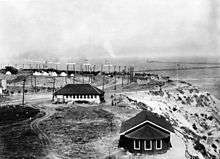
With Connecticut[20] as flagship under the command of Rear Admiral Robley D. Evans, the fleet sailed from Hampton Roads on 16 December 1907 for Trinidad, British West Indies, thence to Rio de Janeiro, Brazil; Punta Arenas, Chile; Callao, Peru; Magdalena Bay, Mexico, and up the West Coast, arriving at San Francisco, 6 May 1908.
At San Francisco, Rear Admiral Charles S. Sperry assumed command of the fleet, owing to the poor health of Admiral Evans. Also at San Francisco, the squadrons were slightly rearranged, bringing the newest and best ships in the fleet up to the First Squadron. Glacier was detached and later became the supply ship of the Pacific Fleet. At this time also, Nebraska, under Captain Reginald F. Nicholson, and Wisconsin, under Captain Frank E. Beatty, were substituted for Maine and Alabama. In San Francisco, Minnesota was brought forward into First Squadron, First Division and Louisiana took her place as flagship, Second Squadron.
Leaving that port on 7 July 1908 the U.S. Atlantic Fleet visited Honolulu; Auckland, New Zealand; Sydney and Melbourne, Australia; Manila, Philippines; Yokohama, Japan; Colombo, Ceylon; arriving at Suez, Egypt, on 3 January 1909.
While the fleet was in Egypt, word was received of an earthquake in Sicily, thus affording an opportunity for the United States to show its friendship to Italy by offering aid to the sufferers. Connecticut, Illinois, Culgoa, and Yankton were dispatched to Messina, Italy at once. The crew of Illinois recovered the bodies of the American consul, Arthur S. Cheney and his wife, entombed in the ruins.
Scorpion, the Fleet's station ship at Constantinople, and Celtic, a refrigerator ship fitted out in New York, were hurried to Messina, relieving Connecticut and Illinois, so that they could continue on the cruise.
Leaving Messina on 9 January 1909 the fleet stopped at Naples, Italy, thence to Gibraltar, arriving at Hampton Roads on 22 February 1909. There President Roosevelt reviewed the fleet as it passed into the roadstead.
First leg
From Hampton Roads to San Francisco, 14,556 nautical miles (26,958 km).
Itinerary
| Port | Arrival | Departure | Distance to next port |
|---|---|---|---|
| Hampton Roads, Virginia | 16 December 1907 | 1,803 nmi (3,339 km) | |
| Port of Spain, Trinidad | 23 December 1907 | 29 December 1907 | 3,399 nmi (6,295 km) |
| Rio de Janeiro, Brazil | 12 January 1908 | 21 January 1908 | 2,374 nmi (4,397 km) |
| Punta Arenas, Chile | 1 February 1908 | 7 February 1908 | 2,838 nmi (5,256 km) |
| Callao, Peru | 20 February 1908 | 29 February 1908 | 3,010 nmi (5,570 km) |
| Magdalena Bay, Mexico | 12 March 1908 | 11 April 1908 | 1,132 nmi (2,096 km) |
| San Francisco, California | 6 May 1908 |
Ships
The Fleet, First Squadron and First Division, were commanded by Rear Admiral Robley D. Evans. First Division consisted of four ships of the 1906 Connecticut class: Connecticut, the fleet's flagship, Captain Hugo Osterhaus, Kansas, Captain Charles E. Vreeland, Vermont, Captain William P. Potter, and Louisiana, Captain Richard Wainwright.
Second Division was commanded by Rear Admiral William H. Emory. Second Division consisted of four ships of the 1904 Virginia class: Georgia, the division flagship, Captain Henry McCrea, New Jersey, Captain William H. H. Southerland, Rhode Island, Captain Joseph B. Murdock, and Virginia, Captain Seaton Schroeder.
Second Squadron and Third Division were commanded by Rear Admiral Charles M. Thomas. Third Division consisted of one Connecticut-class ship and the three ships of the 1902 Maine class: Minnesota, the squadron flagship, Captain John Hubbard, Maine, Captain Giles B. Harber, Missouri, Captain Greenlief A. Merriam, and Ohio, Captain Charles W. Bartlett.
Fourth Division was commanded by Rear Admiral Charles S. Sperry. Fourth Division consisted of two ships of the 1901 Illinois class and the two 1900 Kearsarge-class ships: Alabama, the division flagship, Captain Ten Eyck De Witt Veeder, Illinois, Captain John M. Bowyer, Kearsarge, Captain Hamilton Hutchins, and Kentucky, Captain Walter C. Cowles.
The fleet auxiliaries consisted of Culgoa (a storeship), Lieutenant Commander John B. Patton, Glacier (a storeship), Commander William S. Hogg, Panther (a repair ship), Commander Valentine S. Nelson, Yankton (a tender), Lieutenant Walter R. Gherardi, and Relief (a hospital ship).
The "Torpedo Flotilla" of destroyers consisted of Hopkins, Lieutenant Alfred G. Howe, Stewart, Lieutenant Julius F. Hellweg, Hull, Lieutenant Frank McCommon, Truxton, Lieutenant Charles S. Kerrick, Lawrence, Lieutenant Ernest Friedrick, Whipple, Lieutenant Hutch I. Cone, and Arethusa (a tender), Commander Albert W. Grant.
Second leg
Itinerary

._Fleet_in_San_Francisco_Harbor%2C_Virginia_bow_on%2C_1908_-_NARA_-_512999.tif.jpg)

The second leg of the voyage was from San Francisco to Puget Sound and back. On May 23, 1908 the 16-battleships of the Great White Fleet steamed into the Puget Sound where they separated to visit six Washington state ports: Bellingham, Bremerton, Port Angeles, Port Townsend, Seattle and Tacoma.[21] The fleet arrived in Seattle on May 23 and departed May 27, 1908.[22]
Ships
The Fleet, First Squadron, and First Division were commanded by Rear Admiral Charles S. Sperry. First Division consisted of Connecticut, the Fleet's flagship, Captain Hugo Osterhaus Kansas, Captain Charles E. Vreeland Minnesota, Captain John Hubbard Vermont, Captain William P. Potter.
Second Division was commanded by Rear Admiral Richard Wainwright. Second Division consisted of Georgia, the Division flagship, Captain Edward F. Qualtrough, Nebraska, Captain Reginald F. Nicholson, replacing her sister Virginia, New Jersey, Captain William H.H. Southerland, and Rhode Island, Captain Joseph B. Murdock.
Second Squadron and Third Division were commanded by Rear Admiral William H. Emory. Third Division consisted of Louisiana, the Squadron's flagship, Captain Kossuth Niles, Virginia, Captain Alexander Sharp, Missouri, Captain Robert M. Doyle, and Ohio, Captain Thomas B. Howard.
Fourth Division was commanded by Rear Admiral Seaton Schroeder. Fourth Division consisted of Wisconsin, the Division flagship, Captain Frank E. Beatty, which replaced her sister Alabama, Illinois, Captain John M. Bowyer, Kearsarge, Captain Hamilton Hutchins, and Kentucky, Captain Walter C. Cowles.
The Fleet Auxiliaries were Culgoa (a storeship), Lieutenant Commander John B. Patton, Yankton (a tender), Lieutenant Commander Charles B. McVay, Glacier (a storeship), Commander William S. Hogg, Relief (a hospital ship), Surgeon Charles F. Stokes, and Panther (a repair ship), Commander Valentine S. Nelson.
Third leg
From San Francisco to Manila, 16,336 nautical miles (30,254 km).
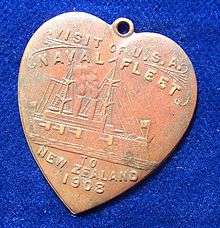
Itinerary
| Port | Arrival | Departure | Distance to next port |
|---|---|---|---|
| San Francisco, California | 7 July 1908 | 2,126 nmi (3,937 km) | |
| Honolulu, Hawaii | 16 July 1908 | 22 July 1908 | 3,870 nmi (7,170 km) |
| Auckland, New Zealand | 9 August 1908 | 15 August 1908 | 1,307 nmi (2,421 km) |
| Sydney, Australia | 20 August 1908 | 28 August 1908 | 601 nmi (1,113 km) |
| Melbourne, Australia | 29 August 1908 | 5 September 1908 | 1,368 nmi (2,534 km) |
| Albany, Australia | 11 September 1908 | 18 September 1908 | 3,458 nmi (6,404 km) |
| Manila, Philippine Islands | 2 October 1908 | 9 October 1908 | 1,795 nmi (3,324 km) |
| Yokohama, Japan | 18 October 1908 | 25 October 1908 | 1,811 nmi (3,354 km) |
| Amoy, China (Second Squadron) |
29 October 1908 | 5 November 1908 | |
| Manila, Philippine Islands (First Squadron) |
31 October 1908 | ||
| Manila, Philippine Islands (Second Squadron) |
7 November 1908 |
Ships
The Fleet, First Squadron, and First Division were commanded by Rear Admiral Charles S. Sperry. First Division consisted of Connecticut, the Fleet's flagship, Captain Hugo Osterhaus, Kansas, Captain Charles E. Vreeland, Minnesota, Captain John Hubbard, and Vermont, Captain William P. Potter.
Second Division consisted of Georgia, the Division flagship, Captain Edward F. Qualtrough, Nebraska, Captain Reginald F. Nicholson, New Jersey, Captain William H.H. Southerland, and Rhode Island, Captain Joseph B. Murdock.
The Second Squadron and Third Division were commanded by Rear Admiral William H. Emory. Third Division consisted of Louisiana, the Squadron flagship, Captain Kossuth Niles, Virginia, Captain Alexander Sharp, Missouri, Captain Robert M. Doyle, and Ohio, Captain Thomas B. Howard.
Fourth Division was commanded by Rear Admiral Seaton Schroeder. Fourth Division consisted of Wisconsin, the Division flagship, Captain Frank E. Beatty, Illinois, Captain John M. Bowyer, Kearsarge, Captain Hamilton Hutchins, and Kentucky, Captain Walter C. Cowles.
The Fleet Auxiliaries were Culgoa (a storeship), Lieutenant Commander John B. Patton, Yankton (a tender), Lieutenant Commander Charles B. McVay, Glacier (a storeship), Commander William S. Hogg, Relief (a hospital ship), Surgeon Charles F. Stokes, and Panther (a repair ship), Commander Valentine S. Nelson.
Final leg
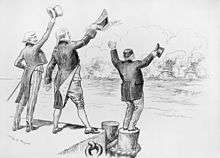
The final leg ran from Manila to Hampton Roads, 12,455 nautical miles (23,067 km).
Itinerary
| Port | Arrival | Departure | Distance to next port |
|---|---|---|---|
| Manila, Philippine Islands | 1 December 1908 | 2,985 nmi (5,528 km) | |
| Colombo, Ceylon | 13 December 1908 | 20 December 1908 | 3,448 nmi (6,386 km) |
| Suez, Egypt | 3 January 1909 | 4–6 January 1909 | 2,443 nmi (4,524 km) |
| Gibraltar | 31 January – 1 February 1909 | 6 February 1909 | 3,579 nmi (6,628 km) |
| Hampton Roads, Virginia | 22 February 1909 |
Experience gained
The cruise of the Great White Fleet provided practical experience for US naval personnel in sea duty and ship handling. It also showed the viability of US warships for long-range operations as no major mechanical mishaps occurred. However, while the cruise uncovered design flaws, it did not test the abilities to engage in battle fleet action. In fact, the success of the deployment might have helped obscure design deficiencies that were not addressed until World War I. These included excessive draft, low armor belts, large turret openings and exposed ammunition hoists.[23]
Effects on US capital ship design
While the capital ships of the Great White Fleet were already obsolescent in light of the "big gun" revolution ushered in by the construction of HMS Dreadnought, their behavior at sea furnished valuable information that affected future construction. For instance, in terms of seaworthiness, all the capital ships in the fleet proved wet in all but the calmest seas, which led to the flared bows of subsequent U.S. battleships, increased freeboard forward and such spray-reducing measures as the elimination of bill-boards for anchors and gun sponsons. Increased freeboard was needed; this and related considerations demanded increases in beam and overall size. Between the Florida-class battleships, the last American capital ships completed before data from the cruise became available, and the Wyoming class, the first designed after this data was received, displacement (and, as a result, cost) per ship increased by one third.[24]
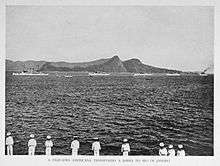
Deficiencies in seaworthiness in turn reduced the battle-worthiness of the fleet. Turret heights for main armament proved too low and needed to be raised. Secondary armament was useless at speed and especially in trade-wind conditions (with the wind moving over the sea at 10 knots (19 km/h) or greater) and needed to be moved much higher in the hull. Improved placement began with the Wyoming-class battleships and was further refined in the Nevada class. Casemates for the bow 3-inch guns in the newer pre-dreadnoughts were untenable due to wetness and were removed. Another discovery was that, even when fully loaded, the bottom of the battleships' side armor was visible—and the ships thus vulnerable to shells that might hit beneath it to reach their machinery and magazines—in smooth to moderate seas. The profile of crests and troughs in some ships contributed to this problem. Admiral Evans concluded that the standard 8-foot (2.4 m) width of belt armor to be inadequate.[25]
One other necessity the cruise outlined was the need for tactical homogeneity. Before the cruise, critics such as then-Captain William Sims (to whom President Roosevelt listened) had argued that American warship design had remained too conservative and precluded the level of efficiency needed for the fleet to function as an effective unit. The cruise proved the charge true. This would eventually lead to the building of standard type battleships in the U.S. Navy. When President Roosevelt convened the 1908 Newport Conference of the Naval War College, he placed responsibility for U.S. battleship design on the General Board of the United States Navy. This gave line officers and planners direct input and control over warship design, a pattern which has persisted to the present day.[26]
Effects on fleet operations
Experience gained by the cruise led to improvements in formation steaming, coal economy and morale. Gunnery exercises doubled the fleet's accuracy. However, the mission also underlined the fleet's dependence on foreign colliers and the need for coaling stations and auxiliary ships for coaling and resupply.[23]
See also
- Big Stick ideology
- Peace through strength
- List of circumnavigations
- Operation Sandblast, a Cold War circumnavigation by the US Navy with a submarine
- Operation Sea Orbit, a Cold War circumnavigation by the world's first all-nuclear squadron
- Exercise Summer Pulse, a worldwide test of the U.S. Navy's Fleet Response Plan (FRP)
- Cruise of the Special Service Squadron
References
- 1 2 3 JO2 [Journalist Second Class] Mike McKinley (April 1, 2015). "Cruise of the Great White Fleet". Naval History and Heritage Command. Retrieved November 11, 2015.
- 1 2 3 The Great White Fleet by Department of the Navy-- Naval History and Heritage Command Archived copy at the Library of Congress (February 4, 2012).
- ↑ John Mack Faragher [et al.] Out of Many: a history of the American People. Prentice Hall, 2012. p. 574.
- ↑ Hart 1965, pp. 15–21.
- ↑ Circling the Globe: The Voyage of the Great White Fleet by Kennedy Hickman, About.com
- ↑ Hart 1965, p. 21.
- 1 2 The Peaceful Sea. "The Great White Fleet Visits Japan 1908". Retrieved February 24, 2011.
- ↑ Global Security Org. "Great White Fleet (16 Dec 1907 – 22 Feb 1909)". Retrieved February 24, 2011.
- 1 2 Hart 1965, p. 24.
- ↑ Crawford 2008, p. 12.
- ↑ Hart, 1965, pp. 23-24.
- ↑ Albertson 2007, pp. 30-31.
- ↑ Albertson 2007, pp. 31-34.
- ↑ James R. Reckner, Teddy Roosevelt's Great White Fleet, 2001, p. 16
- ↑ Albertson 2007, pp. 34-35.
- ↑ Busch p. 86, 87
- ↑ Semenov p. 16, 17
- ↑ "Great White Fleet revisits Sydney Harbour". Afloat. Afloat Publications Pty Ltd. 2008-09-01. p. 40.
- ↑ The US 'Great White Fleet' arrives in Auckland (from the 'NZ History' website, retrieved 3 August 2007)
- ↑ Great White Fleet USS Connecticut, Battleship BB-18
- ↑ http://www.navy.mil/gwf/pugetsound.htm
- ↑ https://books.google.com/books?id=OVtFbZqPskgC&lpg=PA54&ots=En0kweqzfQ&dq=great%20white%20fleet%20May%2027%2C%201908&pg=PA54#v=onepage&q=great%20white%20fleet%20May%2027,%201908&f=false
- 1 2 Crawford 2008, p. 6.
- ↑ Friedman 1985, pp. 75-85.
- ↑ Friedman 1985, pp. 75-9.
- ↑ Friedman 1985, pp. 75, 82.
- ↑ The Russian fleet had no coaling stations and foreign coaling stations were off limits to them during their voyage. The fleet had to refuel at sea via German contractor coaling vessals or on the sly at French ports.(Busch 86, 87)
Bibliography
World Cruise of the Great White Fleet
- Albertson, Mark (2007). They'll Have to Follow You Home!: The Triumph of the Great White Fleet. Mustang, Oklahoma: Tate Publishing & Enterprises LLC. ISBN 978-1-60462-145-7.
- Crawford, M. J., The World Cruise of the Great White Fleet: Honoring 100 Years of Global Partnerships and Security. (2008)
- Friedman, Norman (1985). U.S. Battleships: An Illustrated Design History. Annapolis: Naval Institute Press. ISBN 0-87021-715-1. OCLC 12214729.
- Hart, R. A., The Great White Fleet: Its Voyage Around the World, 1907–1909. (1965)
- Nolte, Carl, "Great White Fleet Visited S.F. 100 Years Ago", San Francisco Chronicle, 6 May 2008 pg. B3.
- Reckner, J. R., Teddy Roosevelt's Great White Fleet: The World Cruise of the American Battlefleet, 1907–1909. (1988)
- Wimmel, K., Theodore Roosevelt and the Great White Fleet: American Sea Power Comes of Age. (1998)
Russo-Japanese War
- Busch, Noel F. The Emperor's Sword; Japan vs. Russia in the Battle of Tsushima. 1969. Funk & Wagnalls, New York.
- Corbett, Julian, Sir. Maritime Operations in the Russo-Japanese War 1904–1905. (1994). Originally classified Secret/Confidential until the 1950s; published in two volumes. ISBN 1-55750-129-7
- Pleshakov, Constantine. The Tsar's Last Armada: The Epic Voyage to the Battle of Tsushima. (2002). ISBN 0-465-05792-6
- Semenov, Vladimir, Capt. The Battle of Tsushima. (1912). E.P. Dutton & Co.
External links
| Wikimedia Commons has media related to Great White Fleet. |
- US Navy Historical Center Site
- Naval Auxiliary Air Station, Monterey
- Guide to the Theodore W. Richards Great White Fleet Scrapbook, 1908–1909; 1916; 1945 MS 219 held by Special Collection & Archives, Nimitz Library at the United States Naval Academy
.jpg)
